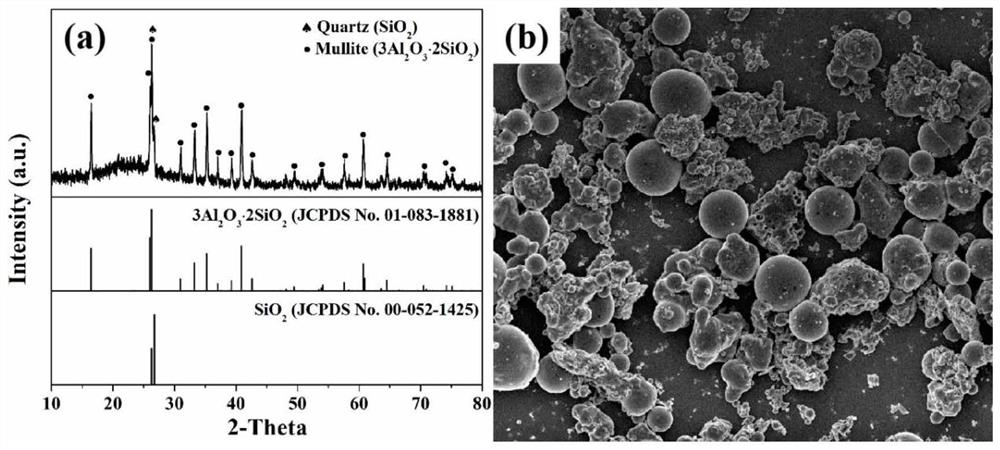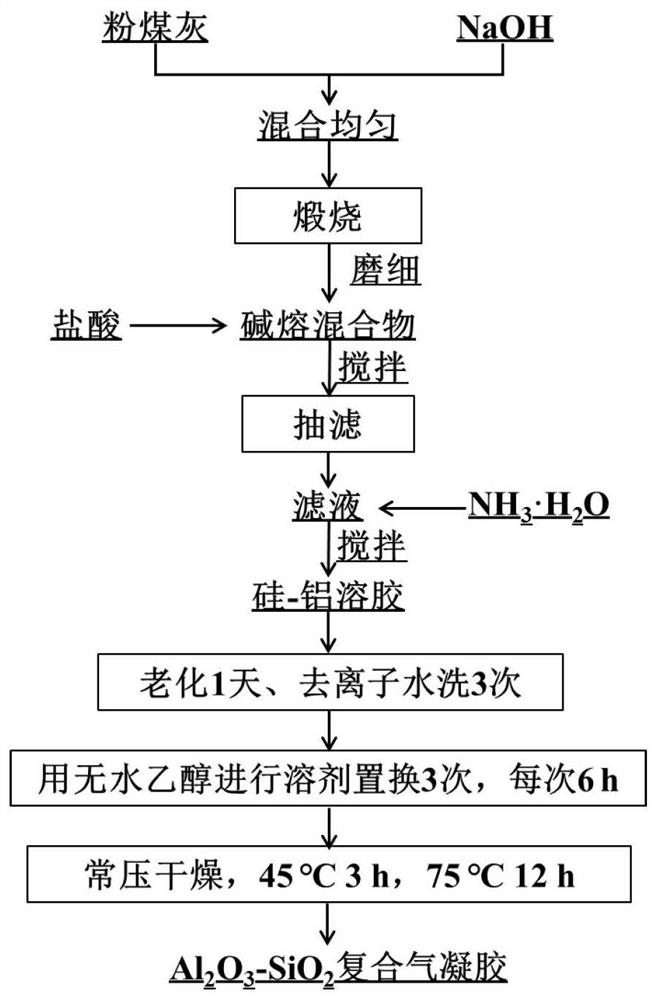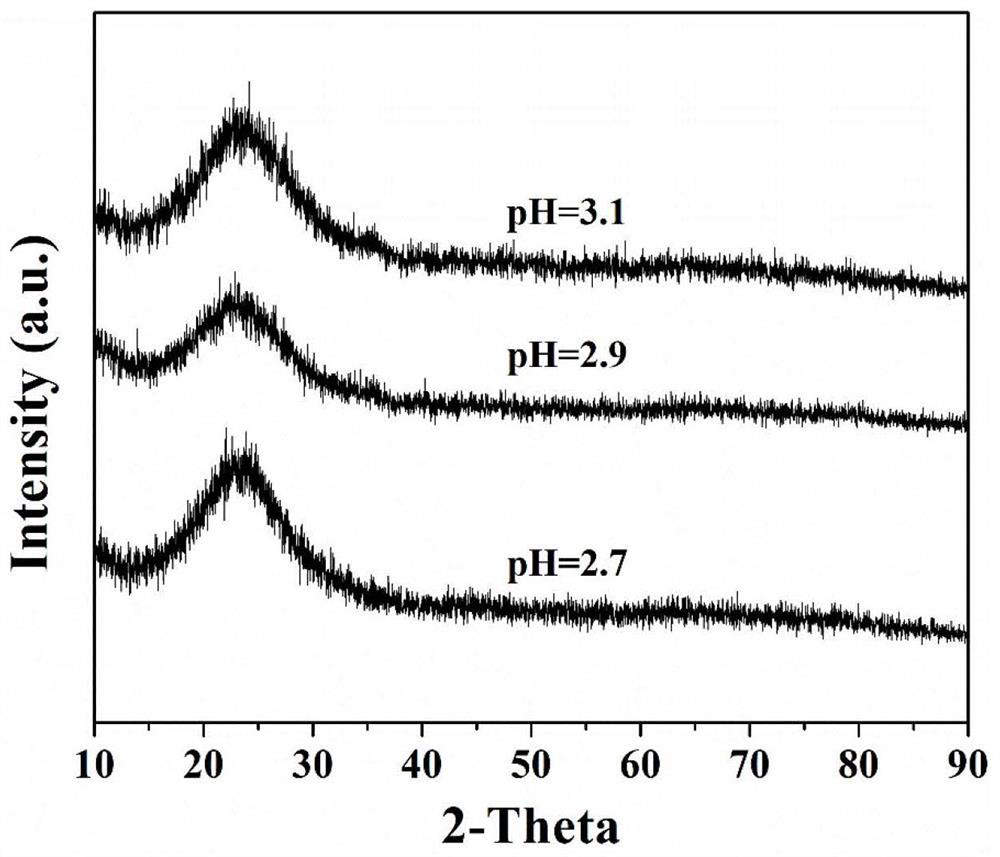A kind of preparation of sio from fly ash 2 -al 2 o 3 Method for compounding aerogel materials
A technology of composite airgel and fly ash, applied in the field of mesoporous materials, achieves the effect of low cost, short process and short process
- Summary
- Abstract
- Description
- Claims
- Application Information
AI Technical Summary
Problems solved by technology
Method used
Image
Examples
Embodiment 1
[0031] Example 1 (see the process flow figure 2 )
[0032] (1) Mix the fly ash and sodium hydroxide (mass ratio is 1:0.8) uniformly, place it in a muffle furnace, and calcinate at 350°C for 2 hours.
[0033] (2) Grind the alkali fusion mixture obtained in step (1), take 5 g of the alkali fusion mixture, add 30 ml of hydrochloric acid (5 mol / L) and 40 ml of deionized water, and stir until the reaction is complete.
[0034] (3) Filter the mixed solution in step (2) to obtain a solution containing silicon and aluminum.
[0035] (4) Ammonia water (0.25mol / L) was added to the solution obtained in step (3), and the pH of the solution was controlled to be 2.7.
[0036] (5) After aging the gel obtained in step (4) for 1 day, wash it twice with deionized water.
[0037] (6) The gel obtained in step (5) is replaced with anhydrous ethanol for solvent replacement, and dried in an oven at 45° C. for 3 hours and at 75° C. for 12 hours.
Embodiment 2
[0038] Example 2 (see the process flow figure 2 )
[0039] (1) Mix the fly ash and sodium hydroxide (mass ratio is 1:1) evenly, place it in a muffle furnace, and calcine at 400 ° C for 1.5 hours.
[0040] (2) Grind the alkali fusion mixture obtained in step (1), take 6 g of the alkali fusion mixture, add 25 ml of hydrochloric acid (5 mol / L) and 30 ml of deionized water, and stir until the reaction is complete.
[0041] (3) Filter the mixed solution in step (2) to obtain a solution containing silicon and aluminum.
[0042] (4) Ammonia water (0.35mol / L) was added to the solution obtained in step (3), and the pH of the solution was controlled to be 2.9.
[0043] (5) After aging the gel obtained in step (4) for 2 days, wash it three times with deionized water.
[0044] (6) The gel obtained in step (5) is replaced with anhydrous ethanol for solvent replacement, and dried in an oven at 45° C. for 3 hours, 65° C. for 12 hours, and 75° C. for 12 hours.
Embodiment 3
[0045] Example 3 (see the process flow figure 2 )
[0046] (1) Mix the fly ash and sodium hydroxide (mass ratio is 1:1.2) evenly, place it in a muffle furnace, and calcine it at 500°C for 1 hour.
[0047] (2) Grind the alkali fusion mixture obtained in step (1), take 4 g of the alkali fusion mixture, add 35 ml of hydrochloric acid (5 mol / L) and 35 ml of deionized water, and stir until the reaction is complete.
[0048] (3) Filter the mixed solution in step (2) to obtain a solution containing silicon and aluminum.
[0049] (4) Ammonia water (0.5mol / L) was added to the solution obtained in step (3), and the pH of the solution was controlled to be 3.1.
[0050] (5) After aging the gel obtained in step (4) for 3 days, wash with deionized water 4 times.
[0051] (6) The gel obtained in step (5) was replaced by anhydrous ethanol, and dried in an oven at 45°C for 3 hours, 55°C for 6 hours, 65°C for 12 hours, and 75°C for 12 hours.
PUM
| Property | Measurement | Unit |
|---|---|---|
| specific surface area | aaaaa | aaaaa |
| pore size distribution | aaaaa | aaaaa |
| specific surface area | aaaaa | aaaaa |
Abstract
Description
Claims
Application Information
 Login to View More
Login to View More - R&D
- Intellectual Property
- Life Sciences
- Materials
- Tech Scout
- Unparalleled Data Quality
- Higher Quality Content
- 60% Fewer Hallucinations
Browse by: Latest US Patents, China's latest patents, Technical Efficacy Thesaurus, Application Domain, Technology Topic, Popular Technical Reports.
© 2025 PatSnap. All rights reserved.Legal|Privacy policy|Modern Slavery Act Transparency Statement|Sitemap|About US| Contact US: help@patsnap.com



